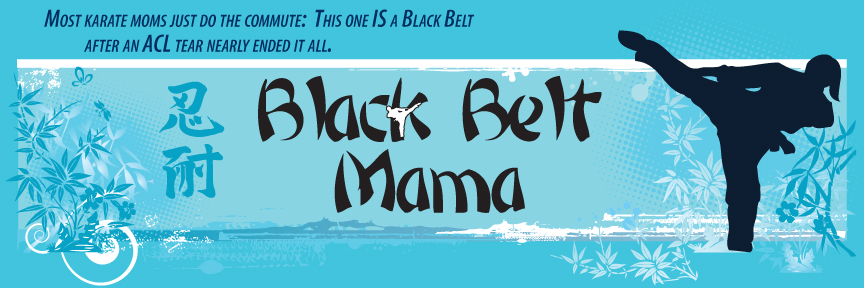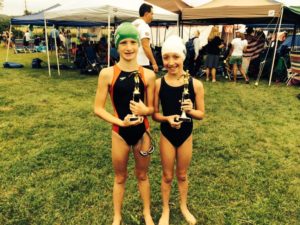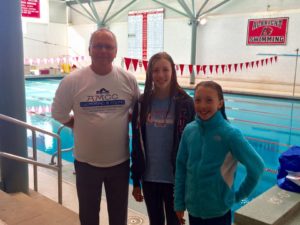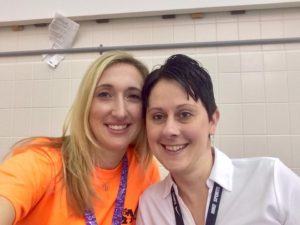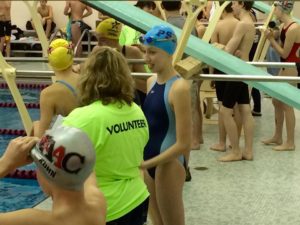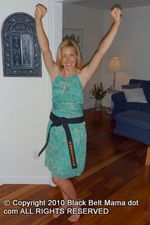August 22, 2019
All I Did was Blink
It feels like just yesterday that I was writing about my oldest’s first day at Kindergarten. It was an absolutely gut-wrenching day for me. In fact, I couldn’t imagine going through anything as terrible again. I figured I would be plenty distracted with Sassy, but she took an epic nap that day and I was alone with my misery. But I got through it and went on to survive a series of other gut-wrenching parental moments, like the first time Swim Girl drove to early morning practice on her own, and getting through one seriously awful official visit weekend where I just wanted to go pick her up and rescue her but instead spent the entire time on “Find my iPhone,” just in case I seriously needed to jump in an Uber and go bust her out of there like a Navy Seal.
And then I blinked, and now it’s just two days until she will be moving into her dorm. . . all I did was blink.
I imagine that move-in day will feel much like Kindergarten did, and that the drive home will feel only about 1000 times worse. Instead of 3.5 hours after drop-off, I’ll be able to see her again in about six weeks. It seems almost unfathomable. Six weeks. I don’t think we’ve ever been apart for more than five days. How will I get through a solid month?
Last weekend, while Swim Girl was saying goodbye to some friends, the rest of us went school supply shopping. While Swim Girl and Little Man ran around the store gleefully throwing various supplies into the cart, I kept getting choked up. It feels weird with just the four of us. At one point in the car, I just started crying. Spontaneous crying has been a regular thing around here lately, and I’m not usually one to just burst into tears. When I’m having these moments, I try to talk myself out of them by reminding myself that I had a solid and constant 18 years with her and that she’s ready to go. I have reassured myself multiple times that I have raised a girl with such a good head on her shoulders, a girl who will make smart choices and take off at school, both in the classroom and in the pool. I remind myself that she will be swimming with a coaching staff that literally feels like she’ll be getting a 2nd and 3rd dad (and a really cool big brother). They already care about her. I have no doubt that her coaches and team will be looking out for her. Being an athlete in school gives her a safety net others don’t have and I am so grateful for that. And then I start thinking about all the hurdles and challenges she has overcome, how she dreamed of swimming in college and look at her. . . here she is, a Division 1 scholarship athlete, and I just start bursting with pride. . . and then I get all teared up all over again.
I know I’m not alone in this as I have talked to multiple moms who have dropped off their sons and daughters in the last week. We’re all emotionally fragile right now. We’re all giant storm clouds ready to burst at any moment. One friend said she faked an asthma attack when she realized she was breaking down as she said “goodbye.” I imagine that, just like with Kindergarten and driving and all of the other things, it will get easier with time. In fact, in my brain I know it will. But realizing I won’t be able to make it to all of her swim meets due to conflicts with Sassy and Little Man’s schedules…gut-wrenching. And I know I’m probably going to need to be talked down from using “Find my iPhone 24/7” for at least a little while. No one tells you these things when you become a mother. No one prepares you for how very fast it all goes. You can know they will be ok and that it will get easier in your head, but it’s your heart that feels lost and broken. There is no doubt about it; this weekend is going to be so very hard.
October 4, 2018
Nintai…It Runs in the Family
The kanji design that is the heart and soul of this site has been my mantra for a long time. . . nintai. Persevere. It was the kanji hand painted onto the crutches that got me through three knee surgeries . It was the thought always in my head as I worked on flexion at PT and celebrated each accumulating degree. It was the motto of the move that took me away from my family, friends, swim team, and dojo. You just keep putting one foot in front of the other. You can get through anything if you just keep going.
So it seems only fitting that my 1000th post would be about perseverance as well. But today, I don’t want to write about all I have persevered through. Instead, I’d like to write about Swim Girl, my senior in high school, my beautiful, smart and talented 17-year old who first made her “blog character” appearance 12 years ago, in 2006, as “Big I.” Although I took a writing hiatus, her early years were documented here. And during that hiatus, she has really grown up.
Swim Girl has always loved swimming, even when she was not so great at it. After moving to VA, she began trying some longer distance events and discovered that she was pretty good at swimming them. For a while, she continued to drop time in those events. I looked forward to her swimming the 1650 free, because it was fun to see how much time she could drop. And then the drops came to a halt. Swim Girl described the same thing after every race. She felt like she couldn’t breathe, that her throat was closing up, that there was a lump in her throat preventing her from breathing. It was during allergy season when she first described these symptoms, so I didn’t think much of it. She was diagnosed with exercise-induced asthma when she was younger. I figured the allergies were just exacerbating the asthma.
Then, just weeks before Senior Champs of her sophomore year, there was a chlorine chemical spill at her practice facility. Six of our swimmers had to go to the ER, including Swim Girl. She felt like her lungs had been fried. After ER breathing treatments and two rounds of steroids, she started to feel a little better. But her events at Senior Champs were nowhere near where they should have been time-wise. She entered her Junior year, hoping for better days ahead.
As her Junior year started, Swim Girl couldn’t help but wonder why she always seemed the most out of breath at practice. She had barely taken a break between seasons and was attending all practices. She started to feel frustrated, but thought that maybe the hot pool and air temp were contributing to her asthma difficulties. She never seemed to get the lanes with the “good air,” so she figured it was a combination of things and kept on going.
During an October meet, where she was put in multiple distance events, I watched her fade back in the 1650, her splits completely off of where she should have been, even for an early season meet. When she finished the race, she was purple. She described the same feeling again, and we decided we needed a doctor’s appointment to reevaluate her asthma inhalers and make sure that her lungs had healed from the chlorine spill. It was during this appointment that our pediatrician suspected Swim Girl was suffering from Vocal Cord Dysfunction. The tight feeling in her throat was her vocal cords getting a message from her brain to close instead of open when she needed to breathe most. We were referred to a pulmonologist to confirm the diagnosis.
After a pulmonary function test, we met with the pulmonologist and he confirmed that Swim Girl had a classic example of VCD. He showed us a pulmonary function test graph that indicates a diagnosis of VCD. He then showed us Swim Girls’. They were identical. At first, we were relieved to have some answers. I figured there was a medication they could give her and it would stop. But unfortunately, with VCD, that is not the case. There is no medicinal cure. To double-check that there was nothing else going on, the pulmonologist referred us to an ENT doctor and her team which included a speech therapist. They put a small scope with a camera into Swim Girl’s throat to see her vocal cords. The diagnosis was confirmed once again. In the absence of any visible problem, VCD was the culprit.
We were referred to a speech therapist so that Swim Girl could learn how to breathe in a different way to combat the VCD attacks she would get while swimming. We spent two months going to appointments, where she focused on “belly breathing,” and on learning ways to stop (or at least minimize) an attack when it happened in the water. The challenging part is that quick inhales (imagine trying to take a fast sip) while swimming can be counterproductive. Swim Girl’s speech therapist told her that she needed to slow down during practice until she had mastered the new way she had to breathe. “No,” she told him, “I’ll just figure out how to swim fast and do it.”
Instead of doing her “double” practices with her team, she began doing some of them on her own at the local YMCA so she could slow down and work on her breathing. Sometimes the breathing techniques worked and sometimes they didn’t. Sets with little rest were torture for her. Without having time to reset her breathing, she would end up spending an entire practice just trying to calm her breathing back down. Sometimes, she began seeing spots and feeling like she would pass out. Swim Girl’s speech therapist told her that stress can make VCD worse, so he worked with her on relaxation techniques as well.
Physically, she was struggling with trying to figure out how to implement her breathing techniques during certain strokes (breast and fly for example); and mentally, she was struggling too. Her speech therapist continued to encourage and pump her up, and she was attending at least 7 practices a week at this point AND was doing extra practices on her own at the YMCA plus working out with her trainer. At practice, she focused on backstroke since she had figured out the breathing for that stroke. She didn’t feel it was possible to try to figure it out with the other strokes, not at a team practice.
Swim Girl started doing her own research into her condition. There had to be something she could do that would help. She found research studies that cited a different inhaler having an impact due to its anti-inflammatory properties. We made an appointment with the doctor and Swim Girl presented the study and got her inhaler switched. She also read many articles about how many swimmers with VCD found that it was too challenging of a condition to continue swimming. She wasn’t going to let VCD make her quit. She found a blog of a swimmer who had VCD and started reading her posts. This swimmer put herself on a gluten free diet and it seemed to help. That week, we were at the grocery store, restocking our pantry and changing the way our entire family eats. Swim Girl was working so hard and we wanted to support her efforts in any way we could.
At Senior Champs during her Junior year, Swim Girl dropped from a 2:12.92 in 200 back to a 2:07.19. She went from 63rd place to 9th, and then scratched into the “A” final. She needed a 2:05.99 to make her NCSA Junior National cut. Swim Girl spent the afternoon doing all of the things she needed to do to get ready for finals. . . ice bath, heating pads, water, healthy foods, a nap. She told me she could go faster than she had in the morning and I believed her. She talked out the race and told me where she could cut time on her start, turns, etc. I went to the lobby to give her some peace and quiet. I returned back to our hotel room to pack up and get back to the pool. Swim Girl was pumped up and positive. I told her I believed she could do it, and I did.
That night, Swim Girl dropped more time, to a 2:06.99, exactly 1 second off of the Jr. National time she was chasing. She took 3rd place overall, after being entered in 200 back with a bonus time. From 63rd to 3rd is pretty remarkable. We had a celebratory dinner that was preceded by some tears. She had been through so much. It would have been amazing if that one extra second could have been gone. She had started the year with a 2:15 in 200 back. To get to a 2:06.99 was a big accomplishment. While the Jr. National team competed in FL the following week, Swim Girl went to practice and continued to work on her backstroke and breathing techniques. After all of this, we were surprised when her name was announced as the 15-16 Female Swimmer of the Year at our team banquet.
At a long course meet in May, Swim Girl dropped a considerable amount of time in her backstroke events. She finished 1/4 of the pool ahead of her competition. On the last day of the meet, Swim Girl had to swim the 400 IM, an event that made her VCD flare up almost worse than the 1650. As I timed her and cheered her on, she was fading back and fast. She didn’t look good and I kept trying to watch her breathing. I knew she was having issues. She finished with a huge time add. Her lips were blue. She struggled to get out of the water and staggered to a wall. I left her alone so she could concentrate on her breathing. The stridor from her VCD was so loud, you could hear it four lanes away. It took her a solid 15 minutes to get her breathing under control again. When she could finally talk, she told me she started seeing spots, and then almost all black. The distance events had to go. In the locker room, she heard girls from another team discussing how she had “died” in the race. She was embarrassed and frustrated. It was time for a change in her training.
Heading into Senior Champs, she felt positive again after training in a new location. For the first time at a championship meet, Swim Girl had fun, swam relaxed and fast, and had an enjoyable meet. She knocked some serious time off of her 50 free and finally had a breakthrough in 100 breast.
This past August, Swim Girl began training full time with a new coach. She made him aware of her condition, and he asked how he could help. The first few weeks, Swim Girl swam a little slower so she could really concentrate on her breathing techniques and get her year started off right. Her coach built her confidence back up and supported her efforts. As the weeks have gone on, her breathing has become easier and her VCD flare-ups are rare. The environment that has allowed her to take care of herself has been so good for her. Her new coach told me that while some kids find ways to get out of doing things, she is continually looking for ways to keep doing things. He said she never stops at practice. He recognizes what a hard worker she is, and how much effort she puts into practice.
Over 90 colleges and universities have reached out to her so far, to recruit her for swimming. More emails come every week. She has narrowed down her choices and has spoken to all of the coaches about her condition, and all of the coaches have been supportive of her. After meets, they call or text and ask her how she did and how she felt. No one has crossed her off of their recruiting list because of her condition. Instead it has almost been the opposite. They see her drive and desire to stay in the water, even with circumstances that don’t make it easy for her. They see how she has continued to drop time in her events, and how she turned herself into a sprint and mid-distance contender when distance had to be taken off the table.
I see a girl who has always had to fight for it, a girl who gets her little brother off the bus and takes him to KidWatch at the Y so she can get another workout in. I see a girl who has made a gluten free diet a permanent choice, a strong girl who takes such delight in upping her weights at the gym. I see a girl who has maintained a 4.5 GPA throughout high school while getting up at 3:50 a.m. for practice every weekday. I see a girl that has been chosen as the Visual Arts Student of the Year and/or the Photography Student of the Year every year she has been in high school. I see a girl who was chosen to be President of the National Art Honor Society at her school. She is a triple threat: academics, athletics, art. I see a girl that loves swimming, a girl that is unstoppable. Perseverance is in her blood.
September 30, 2018
We Took the Long Way
It is difficult to know how to start after such a long hiatus. Writing has always been a way for me to sort things out, and shaking the rust off will take some time. After all, writing, like most other things, is better with practice. It’s a skill that comes back slowly until the wheels are greased once again. There may not be anyone left out there who ever thought I would return. But that’s ok too. Writing has always been for me; the audience I’ve gathered over the years has been an added and unexpected benefit. Thanks to Facebook, which I still maintain did much to kill blogging in general, I’ve been able to keep in touch with many of my readers during the absence. I’m grateful for your friendship around the world and if you’re back reading this? Thank you even more for having faith I’d be back some day.
After picking up and moving five hours away from family, friends, and all we knew and loved, maintaining a blog while trying to settle into our new life, proved impossible. But it’s been over four years now. I had to move away from a lot of things I loved and cared about; but writing here doesn’t have to be one of them anymore.
Albright Aquatic Club was one of the things we loved and had to leave. A year-round USA Swimming team, AAC was small and felt like family. When we first joined the team, only a handful of swimmers were even competing in meets, less than 10%. Most kids were there to stay in shape for other sports. Some kids were there to jump-start their high school swim season, and when high school swimming started, we never saw them again. We were asked to take over as Co-Presidents in 2011, when the current President decided to take his daughter elsewhere to swim. We knew little about swimming, other than the summer league experience I had gained as President of that organization. But USA Swimming was a different world, with much more to do in order to lead a successful organization.
We quickly learned how to run the club, and then set out to improve our club’s ranking in USA Swimming and to recruit more swimmers to our team. It didn’t take long. After making a much needed coaching change, our numbers soared. We had a limited number of kids we could safely and successfully accommodate; most of our groups filled in less than 24 hours. Parents would drive to our home to hand in their registration papers first. With a kind, knowledgable and well-respected coach at our helm, our rankings improved and our swimmers steadily improved too. The record board needed to be updated on a regular basis. Our kids were qualifying for Junior Olympics and Senior Champs in record numbers. Our coaching staff was doing amazing things. We were so happy about the status of our team that felt more like a family. Personally, our girls were improving at a rapid rate and everyone was having fun.
And then, in the spring of 2014, Mr. BBM got a job offer for a position several states away. He couldn’t really say “no.”
I broke the news to our Head Coach, and we shared a sad moment in the equipment room. We had worked so hard and come so far. We had little time to transition to someone new, but we eased the concerns and promised to be there to assist the team in any way possible. It only made sense to transition to our best friends; one was already playing the role of treasurer. I started creating a transition plan and began to delegate all of the duties of the club. We had no team administrator so registration, meet entries, website maintenance and everything else was my responsibility, with billing the responsibility of the treasurer. I was an unpaid volunteer and poured my heart and soul into the team, and into making sure it would be ok.
After working so hard and so long to get the right people in place to be able to host a first invitational, I was devastated as I realized we would already be gone when we were to host that first meet, in December of 2014. In our LSC, meet directors had to jump through some serious hoops in order for their team to be able to host a meet. Our successors wouldn’t be quite ready yet. It was a no-brainer decision to travel back to Pennsylvania to help our club host that meet, so we did. It had been the same decision to travel back to Pennsylvania for “Counties” with our summer league team, less than a month after we had moved five hours away also. We have always been team players.
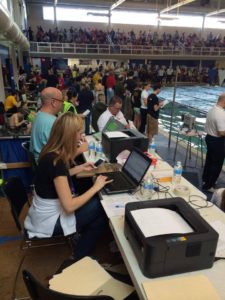
Me, working at Middle Atlantic Junior Olympics so I would have enough sessions logged to be able to help my team run their own invitational.
Although it got off to a rocky start with some equipment malfunctions at the pool we rented, by the next morning, we were rolling and things were running smoothly. It was a packed meet for a first meet. My girls wore their new team caps and represented their club from several states away; but it was like they had never left this team, our second family.
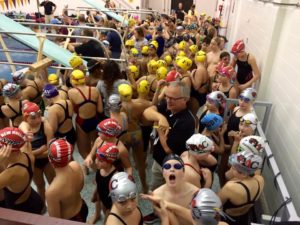
The meet was packed; and we were so excited to be hosting our first ever invitational meet. -December 2014
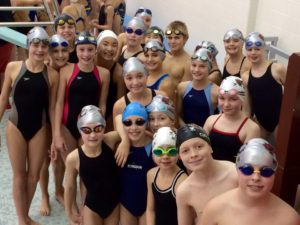
Returning to our team for the meet, it was like we never left. No one minded the blue caps. -December 2014
By the end of the meet, I knew my team was now ready to roll without me. And they did, quite successfully for another two years. The team had built up a financial reserve. They were being led by a wonderful coach and his team of amazing assistants. Whenever we traveled home, the girls practiced with the team and met up with our coach. We’ve continued to stay in touch with almost all the coaches who were a part of our girls’ early years.

When there wasn’t a pool to visit anymore, we still met up with our coach. To this day, we still do. -Summer 2016
AAC had moved up hundreds of spots in virtual club rankings and their meet participation was at an all-time high. It’s amazing how much incentive some cool bag tags with “Competitive Team” on them could suddenly have kids wanting to go to meets, and realizing how much fun it was to go compete. It seemed that nothing could get in the way of this team.
When we were asked to take over as Co-Presidents in 2011, we were also approached by the college where we practiced, who had started the team many years before. They no longer wanted to handle payroll for our coaches. They wanted us to become our own 501c3. We took our team through that process and successfully achieved it in only a few weeks instead of the typical few months. Our pro-bono accountant, from one of the biggest firms in the area, had been impressed with how quickly we had achieved 501c3 status. Now that we were gone a few years, and the head coach for the college was also new, the college wanted to take the club back over again. With our successors also now relocating out of the area, this seemed like the best option for the team.
As I understand it through an email I received from the founder of the club, although the head coach of the college team may have had big ambitions for taking over the team, the controller at the college didn’t want to take over the financial responsibility of the club, and that was the final nail in the coffin. The team’s lane space was rented to a high school team without a pool. Our usual practice times were switched to a 7:30 p.m. start time with a 10 p.m. end time. There was no way that was going to work. The team was unable to start the 2016-2017 season.
AAC was no more.
I was heartbroken. I reached out to anyone I could think of who might be able to help save the team. At my request, the woman who had founded the club in 1994 in her spare time when she wasn’t coaching the college team, reached out to people at the college to no avail. An alumni of the college who is a big swimming supporter who had always targeted his donations to the swim team made some calls as well. But nothing could be done to save the team that had instilled the love of swimming in my girls. Our original swim family had been destroyed.
On the day that I realized every avenue had been exhausted and that it was too late, I was inconsolable. I told friends about what had happened, how upset I was about it, and how heartbroken I was that there was nothing I could do. My mind was five hours away, with the team, coach, and family we had adored. I had been two years removed from the team, and established in our new hometown, but it did nothing to ease the hurt of knowing AAC would no longer exist.
One year later, in August of 2017 and now the President of new team, I would find myself sitting across the table from lawyers and board members of the pool our new team rented, being told with just weeks until our season would begin, that our lease was being terminated. In just two weeks time, our board pulled together, found pool space and saved our team and the jobs of those employed by it. I couldn’t imagine over 200 swimmers being displaced on my watch. I did everything I could to insure our team’s survival, and our board did just that. Our 2017-2018 season started on time. We continued to move our team forward. Perhaps it was because I knew how much it hurt to lose a team that was a family, that I fought so hard to save it.
Fast forward another year, and we transitioned to a new satellite team.
Last week, my oldest daughter, now a senior in high school, said “I love swimming again. It feels like AAC.” On a separate drive to the pool, my youngest daughter, now a 7th grader, said “I just love going to practice. It reminds me of AAC.”
Sometimes we take the long way on a journey to find out where we truly need to be. AAC in Pennsylvania may be gone; but we’ve finally found our AAC here.
June 1, 2015
Transition Hiccups
In a month and a half, our family will have been in our new location, five hours from what we all knew as home, for a year. After an initial adjustment period, for the most part, life has just continued on. The girls have adjusted to their new schools. We’ve made the house our own. We’ve started to venture out in our new surroundings to find our new favorite places and things to do. We’ve all made some new friends. I was warned by several swimming friends that the swimming transition might be the worst one, that a new club and new coaches would take a year to settle into for the girls. I expected that and prepared the girls for it the best that I could.
I didn’t worry about Sassy as much; her outgoing personality always seems to break the ice. After practicing so hard all year long, Sassy began to get her “BB” times and get hungry for more. When she realized how close she was getting to “A” times, she got even more motivated. This past weekend, she swam her very first “A” time in the 50 back, something she didn’t expect that she would do until she turned 10. Despite being the one in our family most vocal about not wanting to move, she has made the swimming transition look easy. A transition at 8 is easier than a transition at 13.
Because I know this, I worried more about Swim Girl, whose quiet and more introspective personality can be more easily misinterpreted by others. I also worried because her relationship with our previous club’s coach was such a strong one. He understood how she was feeling during a practice or after a race, without her having to say a word. He knew her well enough to know that she is a rule-follower and would never skip part of a set to appear faster than someone else. He knew that yelling at her was not the way to motivate her, and that it sometimes took a while for certain things to really sink in. She didn’t believe in shortcuts, and she proved that with her work ethic over the 4.5 years he coached her. He also knew how far she had come and how hard she had worked to get where she is today. Swimming didn’t come naturally to her when she started; but she had the love for the sport that others didn’t always possess. Despite coming in last and getting disqualified, she wanted to work harder and get better. She didn’t give up. She pushed herself and she achieved. It’s this history that her current coaches don’t know, and that she’s too shy and intimidated to share with them.
At the beginning of the short course season this year, Swim Girl was stagnant with her times. But over time, she began to drop her times across all her strokes. She went from a 2:28 in 200 back to a 2:15; from a 1:02 in 100 free to a 56; from a 5:53 in 500 free to a 5:32; from a 1:17 in 100 breast to a 1:12; from a 2:43 in 200 breast to a 2:35; from a 2:28 in 200 IM to a 2:19. Long course season started off with her swimming an Age Group Champs cut in the 1500 the very first time she swam it. The hiccup with her times didn’t last very long at all. She set a goal for herself, that she wanted to qualify for SCY Age Group Champs and make a Senior Champs cut (despite the times being more challenging to get in this state). She did both. One would think her confidence would be soaring, but it’s not.
It’s been good for her to be at a club with so many great swimmers her age. It has taken some of the pressure off, so that she’s been able to just concentrate on her technique and her times. She’s made some very good friends at our new club. But she has some lofty swimming goals she’s shared with me that she’s too afraid to share with her coach. She has questions she wants to ask about how to fix things that stay inside her head instead. She shuts down and stays quiet when she gets yelled at for going too slow, rather than ratting out those who skipped out on part of a set. So many of these kids have been with these coaches for years. They have the kind of relationships with them that she had back home with hers. She’s starting from scratch; and I can tell that it’s bothering her. They don’t know her history and she’s not quite sure how to establish a good relationship without that. As her parent, I feel like I need to help her; but I’m also wary of becoming “that parent,” and feel that at 14, she needs to take the initiative to speak up and communicate with her coach without my interference. I just hope that I can get her to start speaking up.
These are the things that make me miss the easiness that used to be home. In some ways, I’m glad we have an upcoming trip to go back and visit; but I’m also worried that the trip will just make us miss home that much more.
January 31, 2015
The Sport Specialization Debate and Why I’m Sick of Hearing About It
“When dealing with critics, always remember this: Critics judge things based on what is outside the context of their understanding.” -Shannon L. Alder
Several years ago, during the summer swim season, a swim dad approached me and began asking me questions about my oldest daughter and her swimming. At that point, she had been a year-round swimmer for two years. Her improvement from the two summers prior was nothing short of remarkable. I assumed he was talking to me because he was interested in the USA swimming program where she swam, the one I was President of at the time. However, after a few minutes, the conversation turned into something much different. He began talking about kids who play just one sport, and how I was setting my daughter up for injury and failure. Because he didn’t know me (or take the time to get to know me), he was unaware that my daughter had played T-ball, field hockey and had taken a combination of karate and ju-jitsu classes for five years, not to mention the voice lessons. He didn’t know that after trying all of those things, she came to me and said that swimming was what she really loved and that she wanted to focus on that more intensely. It was especially surprising to me, because at the time, she wasn’t very good at it. I was impressed with her desire to get better and her obvious passion for a sport she loved, despite not having had much success.
I spent that summer, and many after it, listening to parents whose kids did not swim year-round making excuses for why their kids weren’t as fast as my kid. I don’t know why they felt such a compulsion to explain this to me. I certainly wasn’t concerned with what their child was or was not doing; unlike them, I wasn’t interested in making comparisons. The nice thing about swimming is that there are times achieved at each meet, so our daughter was only comparing her performance to her prior performances. And she liked what was happening as she watched her times continue to drop. I made it a point to avoid this dad and others like him. I call them the compare/contrast parents. They are constantly holding up their child and anyone who competes against them. They are constantly looking for all the ways their child is better, and all the ways they can get the edge for their kid. When they find one thing that someone else is better at than their child, then it’s excuse-making time. It’s time to cherry-pick an article or two that supports their viewpoint and puts others down to make themselves feel better. It must be exhausting to live that way, which is why I don’t.
Enter the Facebook article re-posts accompanied by stern warnings for parents of single-sport kids, of course from the parents whose kids play multiple sports. A rudimentary chart began circulating on Facebook regarding Ohio State’s football recruits. The number of players on the team who played multiple sports: 42; the number who were one sport only: 5. I guess this is supposed to send me a message that if I want my daughter to play football for Ohio State, I better sign her up quickly for a bunch of other sports. I see this every couple months, the onslaught of negativity at kids (and their oh-so-naive parents) who focus on one sport earlier than others. I get it; there are only so many sports scholarships out there. All of our kids are competing for them, I guess, if that’s your focus already, when your kids are still in elementary and middle school (eye roll). Here’s the thing about our family: while my daughter loves to swim and has expressed that she would possibly like to swim in college, we did not engage her in year-round swimming at the age of 9 so that we could start her on the road to a swimming scholarship. If she gets one some day, that would be wonderful; and I’m sure we’ll all be very pleased. However, that is not, nor has it ever been, our focus with her. Our focus has been on enabling our daughter to achieve at the level she wants to, in a sport that she loves.
All of these articles and re-posts make the same faulty assumption, that parents who support their child specializing in one sport expect scholarships because of it, and force their child into specialization for this very reason. This is a completely false notion and writers of these articles, and all the parents who post them, should stop making assumptions about parental intent. Many things can change from the time a child is elementary/middle school aged to high school, when coaches are actually starting to look at your swimmer. There are a lot of swimmers who peak at age 12 or younger. Performance levels as a “10 and under wonder” do not translate into indications of future success, which is why we have always tried to stay level-headed about swimming, our daughter’s achieved times, and what that might mean for her future. The truth is, what she’s doing now, or what she did years ago, means next to nothing when it comes to her future swimming. She swims because she loves to swim; she has zero interest in playing other sports right now. And although other parents clearly feel very strongly about our daughter’s choice, her choice is perfectly ok.
Swimming has done wonderful things for our daughters. It has allowed them to get into crazy good shape; their endurance is unreal. They have learned about the importance of commitment, attention to detail/technique; and we strongly feel that it’s made both of our girls into very focused students as well. They’ve learned time management and study skills because they work around their swimming/school schedule. In addition, swimming has had a tremendous influence on our younger daughter’s health. A year ago, doctors thought she may have early onset scoliosis. Because I went through the 6-month checkups myself as a kid, I wanted to do something different for my daughter, to see if we could avoid future treatment. After 6 months of seeking help from a PT friend of ours, and having those exercises reinforced during her dry land training at her swim club, and through her in-water practice, the curve in her spine went from almost 9 degrees to less than 5, a number not even considered scoliosis. The specialist at Shriner’s was shocked into complete silence as he compared the two x-rays, before quizzically wanting to know what we were doing. When we told him about her swimming and dry land training, he was shocked and impressed, and told us to keep on doing what we’re doing. It turns out that swimming may save her from the dreaded 6-month checkups for a crooked spine.
Most of the articles warning against single sport specialization point to burn-out and overuse injuries, which is certainly a major concern if your child is a pitcher or a quarterback, using the one same explosive motion all the time, every day, year after year. Swimming is a very symmetrical sport, and a life-long sport with good reason. Have you ever checked out the lap lanes at your local gym? They’re loaded with people who’ve been swimming for decades. A couple articles have pointed out that swimming is quite different from other sports when it comes to specialization in several ways. One of them, “Sport Specialization at a Young Age: Is Swimming Different?” by Dr. Rod Havriluk, Ph.D. states the following:
“The most obvious difference between swimming and other sports is the performance environment. Most sports are land-based, while swimming is performed in the water. Natural human movements (like running, jumping, and throwing) that are applicable to most land-based sports are ineffective in the water. While diversification offers practice on similar skills under different sport conditions, these skills are counterproductive for swimming. Humans cannot rely on innate movement patterns to achieve an expert skill level in swimming. Swimming skills must be learned and the age at which an athlete specializes must be considered.
Most land-based ball sports require movement skills in many directions using varying amounts of range of motion at each joint. Practice for a secondary sport may even train an athlete in a select skill better than the primary sport. For example, practice anticipating and reacting to an opposing player in basketball may help develop similar skills in football. Swimming, however, requires, repetition of the same effective movement sequence on every stroke cycle. Swimming strokes are generally not even remotely replicated in other sports, and certainly not in the water.”
A year ago, my oldest missed a bunch of practices heading into a big meet due to illness. She did not have a good meet; every stroke seemed “off.” Her coach talked to us about swimmers sometimes “losing their feel of the water” when out for extended periods of time. The more practices she attends, the better her feel for the water has been. Non-swimmers won’t understand this concept, but for any swimmer/coach, they know exactly what it means when discussing whether a swimmer has a feel for the water or not. Endurance also has something to do with the reason many swimmers choose to stick with the sport year-round. After even a two-week break, many swimmers have to fight to get back to the level they were at only weeks ago. Those initial practices at the beginning of the season are always brutal for that very reason. It’s also the reason that many swimmers choose to stay in the water. Another key difference when it comes to swimming versus other land-sports is the flexibility required to be effective at the sport of swimming.
“For example, an effective arm recovery in freestyle and butterfly utilizes the full range of motion at the shoulder joint. A young swimmer who learns to use this range can retain it as he/she grows. However, swimmers will not naturally use their full range of motion without considerable quality practice.
In contrast, swimmers who wait until the teenage years to specialize may already have a reduced range of motion at the shoulder, making it far more difficult to master technique elements like the arm recovery in free and fly” (Havriluk).
And here’s something else to consider: “In addition, young teenagers who have not yet specialized may not be very competitive. Less competitive swimmers often have fewer opportunities as far as training time, contact with more skilled coaches, and access to advanced technology. A delay in specialization can present substantial obstacles to ever achieving expert level skills” (Havriluk). I saw this during the first year my daughter swam competitively, before she got involved in club swimming. A “back of the pack” swimmer, the attention that she got was minimal. With 20 kids per lane, how could you blame the coaches for not correcting every technique problem they saw? They simply didn’t have the means to do so. My daughter attended practice regularly, but constantly reinforcing the same bad habits because you don’t know the best techniques isn’t doing you a whole lot of good. Moving to a specialized program, with a more manageable number of kids per lane and a better coach:swimmer ratio made all the difference for her. Choosing to focus on swimming exclusively gave her more free time at home to just be a kid when she wasn’t swimming, riding her bike, reading good books, etc. It killed me when she wanted to quit karate/ju-jitsu and focus just on swimming, but being over-scheduled with too many activities/sports for the sake of diversification and not allowing kids to get proper rest isn’t beneficial either.
Dr. Havriluk concludes with this final statement: “A program that optimizes the quality (emphasis mine, not his) of instruction can offer the advantages of specialization at an early age without the negative consequences.” It’s a sentiment expressed by more than one expert, the idea of quality instruction making all the difference. In the journal article, “Practice Makes Perfect and Other Curricular Myths in the Sport Specialization Debate,” author Jody Brylinsky provides a wealth of evidence that agrees with this concept. “It is not the specialization or diverse sport-training experience that is critical, but the type of training and instruction provided in any training context” (Brylinsky). This concept makes a lot of sense. I have frequently heard of swimmers destroying their shoulders at a young age. But when you couple these swimmers with a steady stint with a coach who’s had zero recent education, who is still pulling work-outs from his memories of three decades ago and killing kids with “junk yardage,” it’s not all that surprising. Call it an overuse injury if you want, but one could easily argue that many of these types of injuries happen because of by sub-par coaching.
There are plenty of coaches out there whose focus is on winning right now, who coach more from ego than they do from the desire to see athletes succeed long-term. I’ve seen them first-hand and avoid them at all costs.These are the ones you want to avoid, especially if your child has chosen to specialize. “Sport skill instruction and sport training that focus on long-term athlete development provide the cumulative advantage to nurture talent, regardless of the training context in which it is offered (Brylinsky). The goal then, becomes placing your young athlete in capable and educated hands. “While multiple-sport participation is presumed to inherently provide a variation in training, this may not always be the case. Many sports require the same physiological demands and use similar training routines” (Brylinsky). The common theme when it comes to avoiding over-use injuries and burnout seems to be an appropriate period of rest, which can be obtained in a singular sport or in a multi-sport environment. Appropriate rest is very important when it comes to athletes of all types. Educated coaches know this. When choosing a program and/or coach for your child, one question to ask them is about their coaching education and whether or not they continue to learn. Coaches who attend conferences, research and move up the levels in ASCA, who try new things at practice and who says things like, “I read an article about. . . ” are the kinds of coaches you want to expose your young athletes to as much as possible. Our oldest daughter started swimming competitively at the age of 8, late by comparison to many of her friends who had been swimming since the age of 5 or 6. The best choice she made (you read that right. . . SHE made the choice), was to ask us to find a private lesson coach to learn proper technique from so she improve. The goal for her was catching up and being competitive, not surpassing everyone and getting a college scholarship. Remember, she was 9 when she made the decision to begin swimming year-round. While I’ve met many parents who fantasize about the idea of college scholarships when their kids are 9, I haven’t met an adolescent yet who has been signed by a college. We tend to be of the level headed swim parent variety: our kids swim because they like to swim, not for the potential freebies they could get down the road.
Although focus on technique is important, especially with a sport like swimming, Brylinsky also stresses the importance of “deliberate play,” defined as “activities regulated by age-adaptive rules controlled by children to maximize enjoyment.” In these types of activities, “children use experimentation of movements without worrying about performance outcomes, fostering an implicit approach to instruction” which can result in “increased retention of new skills, reduced occurrence of reinvestment in complex skills, a heightened sense of competence, and a greater resistance to stress” (Brylinsky). I can think of many activities I’ve seen my swimmer girls do at practice (and at meets) that would fit into these categories, working on achieving negative splits being just one of them. “However, counting on diverse sport opportunities to naturally provide “deliberate play” or “implicit instruction” would be a mistake. Just changing the sport context does not create these useful instructional techniques;” and “Diverse sport experiences will not necessarily produce these learning environments any more than sport specialization prohibits them” (Brylinsky). Again, this relates directly back to the education and skill of your child’s coach. “It would be a mistake to assume that diverse sports opportunities will provide more problem-solving experiences for athletes than specialized single-sport training. Highly qualified coaches will be able to provide an abundance of meaningful practice drills that maximize active participatory-learning in either context. Unqualified coaches, even in a diverse sport environment, may have limited ability to develop an interactive practice or facilitate athlete-led error detection and correction” (Brylinsky). This is one of the things I have always appreciated about USA Swimming, the many opportunities the organization gives for coaches to learn more, via online education, regional conferences and through mentoring programs.
Specialization vs. multi-sport participation seems to be the new parental debate; but it doesn’t have to be. Parents of kids who play multiple sports need to stop making the following assumptions: kids specialize for scholarships, kids specialize because of coach/parent demands. While these assumptions may be accurate for some athletes who specialize, none of these apply to our family, and many other swim families I know. Sometimes, there’s just a kid who loves a sport, and wants to do just that sport. It’s as simple as that. And while I guess I should appreciate the multi-sport participant’s parents for wanting to look out for me and mine, we’re completely comfortable making our own decisions regarding our family, just as I’m sure they’re comfortable making decisions for theirs. People don’t fit into prescribed little categories; and perhaps everyone should try being less judgmental. “The lessons to be learned, however, lie in what the dialogue tells us about the need to focus on quality training and instruction in either sport setting” (Brylinsky). Does your child have high quality coaches in all four sports they play? It’s something to think about.
And if your focus is on your child achieving elite status in their sport of choice, there’s another factor that seems to set apart those who go on to elite status from those who don’t. “When one considers in addition the prerequisite motivation necessary to engage in deliberate practice every day for years and decades, where most children and adolescents of similar age engage in play and leisure, the real constraints on the acquisition of expert performance become apparent. The commitment to deliberate practice distinguishes the expert performer from the vast majority of children and adults who seem to have remarkable difficulty meeting the much lower demands on practice in schools, adult education and physical exercise programs” (Ericsson, Tesch-Romer). Achieving elite status in a sport can not be boiled down to doing just any one thing. It’s a combination of things that make athletes successful: genetics, commitment, motivation, deliberate practice, stellar coaching, nutrition, proper rest periods, etc. When I think about the successful athletes I know, who have gone on to play their chosen sport in college, one thing stands out about them: they simply love what they do. If playing multiple sports makes your young athlete happy, that’s great. Keep letting them do it. But when a child has made the choice to specialize, perhaps others should learn to respect that too.
“How would your life be different if…You stopped making negative judgmental assumptions about people you encounter? Let today be the day…You look for the good in everyone you meet and respect their journey.” -Steve Mariboli “Life, the Truth, and Being Free”
Brylinsky, Jody. “Practice Makes Perfect and Other Curricular Myths in the Sport Specialization Debate.” Journal of Physical Education, Recreation & Dance. 81:8. (2010) 22-25.
Ericsson, K.A. Krampe, R.T., & Tesch-Romer, C. The role of deliberate practice in the acquisition of expert performance. Psychological Review, 100. (1993) 363-406.
Havriluk, Dr. Rod, Ph.D. (2013) Sport Specialization at a Young Age: Is Swimming Different? ASCA Newsletter, 2013 (6) 16.
